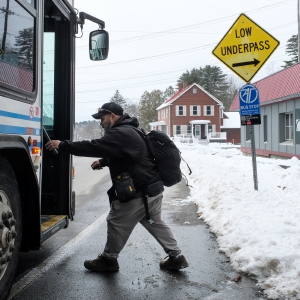A Look Back: White River Junction in the 1950s
| Published: 02-05-2023 9:03 PM |
WHITE RIVER JUNCTION, SUMMER 1957 — It hadn’t changed much in generations and it was still a rugged railroad town, downtown stores hadn’t yet been destroyed by the Vermont sales tax that came a decade later, the slow decay of the 1960s, 1970s and 1980s hadn’t set in and the rejuvenation and hipster vibe were still more than a half century in the future — White River Junction in 1957 is forever locked in among my fondest memories.
I worked that summer at the Swift & Co. branch on South Main Street, an adolescent doing man’s work amid grizzled war veterans ever happy to test the mettle of a strong kid with much to learn about hard physical labor and handling job pressure. I toiled away for $1.10 an hour, kept my mouth shut and got educated about the meat business. But it was the environment around the Swift plant that became ever more fascinating as the weeks of that summer rolled by.
Foremost was the dominance of the railroad. Rail yards stretched a mile south next to the Connecticut River, a half mile northwest along the White and across the bridge to more trackage in West Lebanon. Switching engines shuttled back and forth day and night sorting cars and assembling freight trains for movement along Boston & Maine lines to the south, east and north and the Central Vermont / Canadian National to the northwest. Regularly scheduled passenger trains came and went around the clock, nothing like in the 1940s when 50 or more arrivals a day were the norm, but enough so that there were a half dozen Boston, New York and Montreal departures daily.
In the age of steam, White River Junction and its sister village over the bridge, West Lebanon, shared a common residue of coal smoke and cinders on all their building exteriors. It was a dull dark gray similar to the images of structures portrayed in photographs taken in the late 19th century. By 1957 locomotives were uniformly diesel-powered, but many of the Junction’s buildings had yet to receive fresh paint.
The postal service still ran mail cars, with sorters working on board, and Railway Express had a busy station adjacent to the passenger terminal. Swift had four refrigerated railcars arrive in the yard by 5 o’clock Monday mornings; we’d unload the first two, then call for a switching engine and crew to come and spot the other two on the plant’s siding. Bogle Bothers jewelry store on Gates Street maintained the trainmen’s watches, hanging them on a special board on a wall where the pieces were swapped periodically to be tested for accuracy according to railroad rules.
Rail service supported various enterprises arrayed around the sprawling yards. As many as eight different livestock feed dealers were located between the Junction and West Lebanon; Twin State Fruit got produce by refrigerated railcars, and bulk commodities like coal, lumber and petroleum rolled in, B&M had a large freight house and Cadillacs bound for the Miller Automobile Company on Gates Street came in boxcars.
Across from the Swift plant was a neighborhood market that catered to the Italian community clustered further down South Main, run by a true son of Italy, “Babe” Falzarano. Just up the street was the Junction Restaurant where we Swift workers, attired in our white frocks and aprons, went for morning coffee break. Further up was the downtown district with banks, the Hotel Coolidge, two drugstores, Colodny’s Surprise Department Store, a newsstand, Western Union office, movie theater, stationer, J.J. Newberry’s, post office, diner, furniture store/funeral parlor, state liquor store and a lively bar. Along the fringes were the TipTop Bakery, the Ford dealership, a tire recapping plant, various wholesale distributors, a lumber yard and the White River Hide & Tallow Company, an odoriferous outfit that collected bones, fats and offal from meat and poultry processors over a wide area and forwarded the stuff along to renderers.
About that bar. At the time it was called Teddy’s; later it became the 494, after the Junction’s mascot B&M steam locomotive, old No. 494. The bar was close to a busy underpass and backed up to railroad tracks with their constant shuttling of freight cars. I slipped in a few times and got served without an ID check even though I was only 17. The band was loud and lots of people danced, including an old man who sashayed around the floor by himself but posed as if he had a partner. I learned his name was Frank, was a widower and often came down to Teddy’s from Bethel on the train for the evening and returned home, again by rail, at closing time, a routine he’d been following for years.
Article continues after...
Yesterday's Most Read Articles
 Upper Valley winter shelters kept dozens warm and dry
Upper Valley winter shelters kept dozens warm and dry
 Former principal of South Royalton School released from prison
Former principal of South Royalton School released from prison
 Owner of Friesian horse facility ordered to pay care costs for seized animals
Owner of Friesian horse facility ordered to pay care costs for seized animals
By far the most interesting and engaging business in all of White River Junction in those days was the Lang Hardware store. Its inventory was vast and much of it harkened back to the turn of the 20th century. You could find all kinds of kerosene lamps, candlemaking molds, bungs and spigots for cider barrels, clothes wringers and washboards, knob-and-tube electrical supplies and throwback hand tools. The closest I’ve ever come to a store like it would be an Amish hardware and farm supply store I once visited in Ohio. This emporium was presided over by Windom Lang, who had run it since before World War I.
The commercial side of White River Junction was eclectic and interesting, and the people were similarly diverse and engaging. There were the railroad men, easily spotted in their denim frocks and overalls. Many women worked the shifts as telephone operators at the block-like regional toll center at the edge of downtown. There were Yankee families, French-Canadians, Irish and a large number of Italians whose roots traced back to stonecutters who came to build structures for the railroads at the turn of the 20th century.
White River Junction in 1957 also attracted tramps and hobos, some of whom would show up at the loading dock at the Swift plant looking for a handout. We’d hack off a fist-size chunk of bologna and they’d walk off eating it like an apple.
I grieved when I watched the railroads shrivel, passenger trains vanish and tracks being torn up, taking the heart out of the town. Then it lost its retail stores one by one, Lang Hardware was auctioned off and the Swift plant shuttered along with other wholesale businesses. I came to call myself lucky to have seen and experienced White River Junction at its most vibrant in that summer of 1957.
This article is drawn from the self-published 2021 memoir Stephen Howard Taylor: Recollections of a Life in Newspapering, Farming and Public Service. Taylor lives and farms in Meriden and is a former managing editor of the Valley News.

 Kenyon: No respite from conflict in Upper Valley
Kenyon: No respite from conflict in Upper Valley A Life: Peggy Thorp ‘was critical to getting it all done’
A Life: Peggy Thorp ‘was critical to getting it all done’
